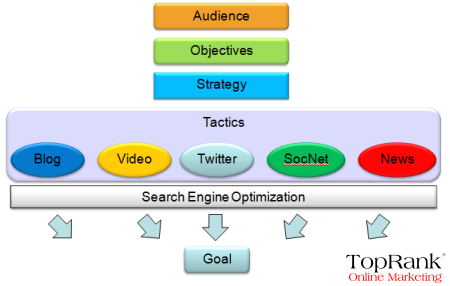 Changes in consumer preferences towards news consumption and sharing habits via the social web present both challenges and opportunities for PR agencies. Searchers increasingly expect to interact with what they find via search.
Changes in consumer preferences towards news consumption and sharing habits via the social web present both challenges and opportunities for PR agencies. Searchers increasingly expect to interact with what they find via search.
The opportunity for Public Relations is to understand that leveraging social media as a distribution channel to attract buzz and earn links is as important as keyword optimization of social media content to improve visibility on standard search engines. Simply put: SEO and Social Media go together like peas and carrots.
The nature of the social web encourages participation: sharing, voting, commenting and linking. Popular social content gets exposure, traffic and can result in a substantial number of relevant inbound links. Keyword relevancy plus aboundant inbound links to content equals improved search engine visibility. Whatever keywords that are used to describe optimized news content that becomes popular within social channels like news, bookmarking and media sharing are what that content will tend to rank highly on in standard search engines.
The lesson for Public Relations is to ensure news content is not only search engine friendly, but social media friendly.

Social interactions and media sharing amongst social network participants tend to create the kind of content that can improve a brand’s visibility within search results through profiles, videos, blog posts, or other media. There’s no reason the same kinds of activities can’t be deployed by Public Relations practitioners. However, this does not mean pushing standard press releases or media relations pitches to social networks, news and media sharing sites. They key to news content on the social web is participation first and a focus on packaging information in useful, creative ways.
Making optimized news content “social media friendly” can be a matter of adding social features such as RSS feeds, bookmarking, “Tweet this” and social news submission links. Adding social features to a press release might be another way of saying “Social Media Press Release” but it may not be necessary to go that far in a format change to gain similar effects. It’s best to leverage both traditional and social formats for news releases and measure what’s working and what’s not.
Leveraging SEO and Social Media for PR benefit is meaningful for reaching journalists and consumers alike. In a 2008 Journalists Use of Search Survey by TopRank, 91% of respondents reported using standard search engines to perform activities such as research companies, past media coverage and subject matter experts. In the same survey, 64% reported using social networks, 55% use blogs and 50% use Wikis as social media tools.
Here is one editor’s story of using both standard and social search which resulted in media coverage:
“I was writing a column about the planned partnership between Google and Yahoo.”
“I tracked down potential sources first using Google and LinkedIn, and came across a white paper prepared by a senior fellow at the American Antitrust Institute.”
“While I could not easily find an e-mail address, I went to Facebook where I located him, then sent a message. He replied and we followed up with a phone interview.”
The increased use of search and social media both by the media and by end consumers should motivate PR professionals to better understand the digital PR strategies and mechanics of successful SEO and social web participation. Keyword optimize social content so it’s more easily discovered within social search and at the same time, leverage social media channels to promote content that can earn links, increasing visibility on standard search engines such as Google, Yahoo, and Live.com.
For more insights on SEO and social media, visit these posts.
This is #9 in a series of ten posts about leveraging search engine optimization with public relations. Read on for our 10th and final post in the series: “Measuring & selling the value of SEO in a Public Relations Environment“.


